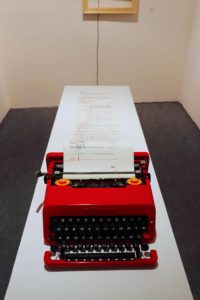 Rimediazioni Analogiche (Analogue Remediation)
Rimediazioni Analogiche (Analogue Remediation)
Donatella Lombardo
2015
Installation, mixed media
145 cm x 90 cm x 40 cm (support included)
Donatella Lombardo’s installation “Rimediazioni Analogiche (Analogue Remediation)” is a red merchantable typewriter, type Olivetti Valentine with a long white panel of cloth coming out of the platen-roller. Digitally printed on the cloth are fragments of source code of the website dedicated to the late Canadian philosopher and media theoretician Marshall McLuhan. The text seems to be typed by the Olivetti. Consequently, there are several bugs in the text, since the typewriter has old fonts, not recognisable by contemporary computer programs. Additionally, the artist embroidered excerpts of music scores, highlighted in red thread.
The first impression is astonishing, because there is a sharp contrast between the analogue typewriter and a digital website’s source code. To decrypt the character set, one needs to know how to read a source code. Nevertheless, even with this ability, the visualisation stays abstract. For a transformation into an understandable image, the source code has to be retyped into a software editor and then a browser can convert the signs into a website. In Donatella’s work, the source code is similar to an X-ray: the actual body remains invisible and one sees only the situation under the skin; here, one sees the data information but the final surface remains concealed. The artist creates a vague depiction of its source, not an accurate reproduction. Self-evident this is intended.
Donatella was inspired by the theory of “Remediation” by Jay David Bolter and Richard A. Grusin. The two scientists assume the incorporation or representation of one medium in another one. Even though, digitalisation changed revolutionary our communication and daily life, it is based on preceding techniques and developments. A simple example is the scripture itself. Donatella demonstrates with her source code fragments of the McLuhan-website that an analogue typewriter can type it, with some exceptions as the marked bugs show. The typewriter itself refers to a much older technique, the Gutenberg’s printing press. Therein included are other preceding techniques of printing and the handwriting. Besides, the western computer keyboard resemble strikingly the analogue typewriters.
Regarding the printing base, Donatella has not chosen paper as it is used nowadays for computer printing or before for typewriters. She opted for cloth. This might be a reference to older writing bases like parchment, papyrus or leather. At the same time, the cloth alludes to media that are more pictorial as painting on canvas, tapestry or even embroidery. Her added stitching indicate this relation. Moreover, this handicraft technique might recall other manual works up to handwriting. Furthermore, her embroidering depicts music scores. Up from the Middle Ages, people searched for signs to write down compositions to conserve and transmit them. Resulting is the current system of musical notation. However, long before, in ancient times, music was a means of communication to diffuse messages, stories and legends.
Altogether, Donatella has incorporated numerous ancient media and means of communication in her installation “Rimediazioni Analogiche” to illustrate the theory of “Remediation”. Additionally, she has chosen the Marshal McLuhan-website as source and with this refers to one of the most important media theoreticians of the 20th century.
Donatella LombardoBorn in 1980 in Erice, Italy, Donatella studied at the Accademia di Belle Arti (Academy of Fine Arts) in Bologna, Italy and continued her post-graduate studies at the Facoltà di Lettere e Beni Culturali di Bologna (Faculty of Cultural Heritage of the University of Bologna). Since her first degree in Fine Arts in 2006, she participated in many group exhibitions and had as well personal shows all over Italy. After her Master’s Degree in Preservation and Restoration of Cultural Heritage in 2011, she cooperated for several exhibitions as curator.
Donatella’s oeuvre varies in subjects and techniques, even though similarities exist. In her early works, embroidery was more dominant. Nevertheless, even today stitches appear in unexpected contexts. In doing so, she refers to this ancient cultural technique applying it to other subjects, for example the new media. Here is an encounter between “technology” and “craftsmanship”, since they mostly show the digital language on natural materials like linen framed by wood. Often the texts are embroidered with red threads. Languages are also on focus; this might be the source code of an html-website or ancient musical notations. Often, her creations are a journey into time, like her “Narrative seismographies”, based on conversations with the inhabitants of the island Ustica, where she was artist in residence in 2018.
Another form of time travel is “Analogue Remediation”, our artwork of the month February 2020. A source code written by an historic typewriter reveals not only the story of written language, there are also connotations to handicraft, music and with that, different forms of communication.
Donatella’s work as co-curator influences her creations, too. For example the two exhibitions “Autoritratti I. Nuove Gen(d)erazioni” (Self-portraits I. Gen(d)erations) and “Autoritratti. Iscrizioni del femminile nell’arte italiana Contemporanea” (Self-portraits. Inscriptions of the feminine in Italian contemporary art) in 2013, coordinated by Uliana Zanetti, lead her once again to question about gender. One result was the series “Partiture mute” (mute scores), where she reproduced 20 compositions of female composers form the middle ages up to the early 20th century. Unfortunately, many of these female creations are forgotten nowadays, but the series brought them into focus. Our artwork of the month February 2017, “Partitura n.1”, is part of this series.
Currently, the mute scores are once again on view in the solo exhibition “Donatella Lombardo. Partiture Mute. Note a margine.” (Mute scores. Side notes.) at the Bolognese Museo internazionale e biblioteca della musica. It is a nice coincidence, since some of the templates are preserved in this institution. Additionally to the musical notations, Donatella created two new works. The show is visible until 23rd February 2020.
Donatella lives and works in Salò, Italy.



